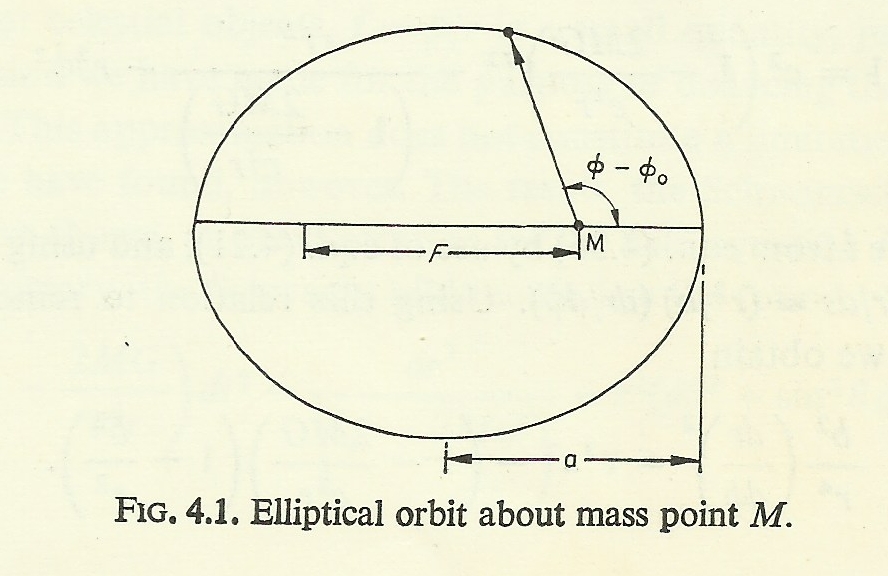Since the perihelion advance of Mercury’s orbit is under discussion, here is maths and the predicted value for the advance.
As in post #10 starting off with the Schwarzschild solution to Einstein’s vacuum equation.
ds² = c²(1-2MG/c²r)dt² - dr²/(1-2MG/c²r) - r²(dθ² + sin² θdϕ²)
Since Mercury exists in a planar orbit θ = π/2, dθ = 0 and sin² θ =1.
The equation reduces to;
ds² = c²(1-2MG/c²r)dt² - dr²/(1-2MG/c²r) - r²dϕ²
Let the geodesic path length increment ds be expressed as a path parameter dk which can be the proper time of a clock.
With ds = dk the equation becomes;
dk² = c²(1-2MG/c²r)dt² - dr²/(1-2MG/c²r) - r²dϕ²
Dividing by dk;
1 = c²(1-2MG/c²r)(dt/dk)² - (dr/dk)²/(1-2MG/c²r) - r²(dϕ/dk)²
(A)
In solving the Einstein’s vacuum equations two mathematical relationships are derived.
dt/dk= a/(1-2MG/c²r) and r²(dϕ/dk)sin²θ = b
dt/dk is eliminated from
(A) and using dr/dk = (dϕ/dk)(dr/dϕ) = (r²/b)(dr/dϕ)
(A) bcomes;
(b²/r⁴)(dr/dϕ)² = c²a² - (1 – 2MG/c²r)(1 + b²/r²)
(B)
Making the substitution u = 1/r
(B) becomes;
(du/dϕ)² = c²a²/ b² - (1/ b²)(1 - 2MGu/c²)(1 + b²u²)
= c²a²/ b² - (1/ b² + u² - 2MGu/c²b² - 2MGu³/c²)
This equation can be simplified by differentiation of both sides with respect to ϕ.
(du²/dϕ²)(du/dϕ) = -(u - MG/c²b² - 3MGu²/c²)(du/dϕ)
If du/dϕ =0 this corresponds to a circular orbit.
Since Mercury has an elliptical orbit divide both sides by du/dϕ.
du²/dϕ² + u = MG/c²b² + 3MGu²/c².
(C)
This equation is Newton’s equation for an orbit without the 3MGu²/c² term.
du²/dϕ² + u = MG/c²b²
We can use Newtonian theory to obtain an approximate solution for
(C).
u = MG/c²b²[1 + ecos(ϕ - ϕ₀)] is a solution for Newton’s equation.
e is the eccentricity of the orbit and ϕ and ϕ₀ are explained in the diagram where ϕ₀ is angle at which perihelion occurs.
Substituting this solution into second term in the right hand side of equation
(C) gives;
du²/dϕ² + u = MG/c²b² + (3M³G³/c⁴b⁴)[1 + ecos(ϕ - ϕ₀)]²
An approximate solution for this equation is;
u = MG/c²b²[1 + ecos(ϕ - ϕ₀ -Δϕ)] where Δϕ = (3M³G³/c⁴b⁴)ϕ and higher order terms of MG/ c²b² are neglected as they are very small.
Note the comparison with the Newtonian solution u = MG/c²b²[1 + ecos(ϕ - ϕ₀)].
Δϕ = (3M³G³/c⁴b⁴)ϕ indicates Δϕ increases with ϕ and is regarded as a constantly increasing correction to ϕ₀ or the precession of the position of the perihelion of Mercury’s orbit.
Plugging in the values for M, G, c and b gives the prediction of Δϕ = 43” per century which compares well with the observed value of 42.98” per century.


